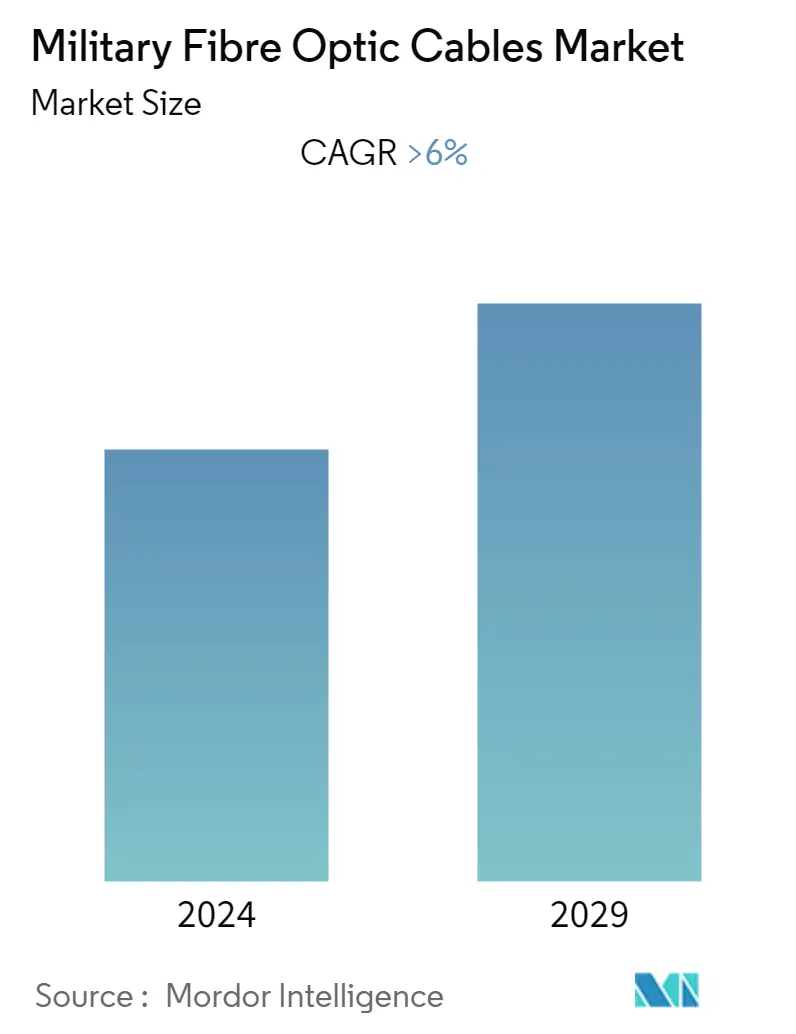Market Size of Military Fibre Optic Cables Industry

| Study Period | 2019 - 2029 |
| Base Year For Estimation | 2023 |
| CAGR | 6.00 % |
| Fastest Growing Market | North America |
| Largest Market | North America |
| Market Concentration | Medium |
Major Players
*Disclaimer: Major Players sorted in no particular order |
Need a report that reflects how COVID-19 has impacted this market and its growth?
Military Fibre Optic Cables Market Analysis
The Military Fibre Optic Cables Market is expected to register a CAGR of over 6% during the forecast period.
The increase in the necessity of enhanced data security, particularly in sectors like the military, where stringent requirements of secure information transfer are prevalent, has increased the growth of the market. There is a large demand for fiber optic cables in the military sector owing to their higher bandwidth capacity, protection against signal interference, and inherent security. The increase in military expenditure for the purpose of modernization of network and communication infrastructure is another factor driving the demand for fiber optic cables. However, the factors, like high initial costs for deployment, the fragile nature of fibers compared to metal wires, and difficulty in connecting them in circuits are hampering the growth of this market. Also, the growth of wireless communication technology and the infeasibility of wired transmission over long distances and diverse terrains are other factors that are expected to restrain the growth of the military fiber optic cables market.
Military Fibre Optic Cables Industry Segmentation
A fiber-optic cable or an optical-fiber cable is an assembly containing one or more optical fibers that are used to carry light. They are used for different military applications including long-distance telecommunication and in various military platforms for faster and more secure communication. The market is segmented by Cable Type, Material Type, and Geography. By Cable type, the market is segmented into Single-mode and Multi-mode. By Material Type, the market is segmented into Plastic Optical Fiber and Glass Optical Fiber. By geography, the market is segmented into North America, Europe, Asia-Pacific, and the Rest of the World. The report provides the market size of the above segments in USD Million.
| Cable Type | |
| Single-mode | |
| Multi-mode |
| Material Type | |
| Plastic Optical Fibre | |
| Glass Optical Fibre |
| Geography | |
| North America | |
| Europe | |
| Asia Pacific | |
| Rest of the World |
Military Fibre Optic Cables Market Size Summary
The military fiber optic cables market is poised for significant growth, driven by the increasing need for enhanced data security and the modernization of military communication infrastructure. Fiber optic cables are favored in military applications due to their high bandwidth capacity, resistance to signal interference, and inherent security features. The rising military expenditure on upgrading network and communication systems further fuels the demand for these cables. However, challenges such as high initial deployment costs, the fragility of fiber optics compared to metal wires, and the complexities involved in circuit connections pose obstacles to market expansion. Additionally, the growth of wireless communication technologies and the limitations of wired transmission over long distances and varied terrains are expected to restrain market growth.
The plastic optical fiber segment is anticipated to dominate the market share, particularly in developing nations, due to its suitability for bandwidth-intensive military applications. These fibers offer advantages such as cost-effectiveness, flexibility, and resilience to environmental factors, making them a preferred choice for military communication networks. North America, led by the United States, is expected to maintain the largest market share, driven by extensive use in tactical communications and military platforms. The market is characterized by fragmentation, with key players like G&H, Timbercon, Inc., and Prysmian Group competing to incorporate advanced technologies into fiber optic assemblies. As the adoption of fiber optic cables in military applications increases, these companies are focusing on enhancing bandwidth, speed, efficiency, and security to secure new defense contracts.
Military Fibre Optic Cables Market Size - Table of Contents
-
1. MARKET DYNAMICS
-
1.1 Market Overview
-
1.2 Market Drivers
-
1.3 Market Restraints
-
1.4 Porters Five Forces Analysis
-
1.4.1 Threat of New Entrants
-
1.4.2 Bargaining Power of Buyers/Consumers
-
1.4.3 Bargaining Power of Suppliers
-
1.4.4 Threat of Substitute Products
-
1.4.5 Intensity of Competitive Rivalry
-
-
-
2. MARKET SEGMENTATION
-
2.1 Cable Type
-
2.1.1 Single-mode
-
2.1.2 Multi-mode
-
-
2.2 Material Type
-
2.2.1 Plastic Optical Fibre
-
2.2.2 Glass Optical Fibre
-
-
2.3 Geography
-
2.3.1 North America
-
2.3.2 Europe
-
2.3.3 Asia Pacific
-
2.3.4 Rest of the World
-
-
Military Fibre Optic Cables Market Size FAQs
What is the current Military Fibre Optic Cables Market size?
The Military Fibre Optic Cables Market is projected to register a CAGR of greater than 6% during the forecast period (2024-2029)
Who are the key players in Military Fibre Optic Cables Market?
G&H, Timbercon, Inc., OFS Fitel, LLC, Sumitomo Electric Lightwave Corp. and Prysmian Group are the major companies operating in the Military Fibre Optic Cables Market.

